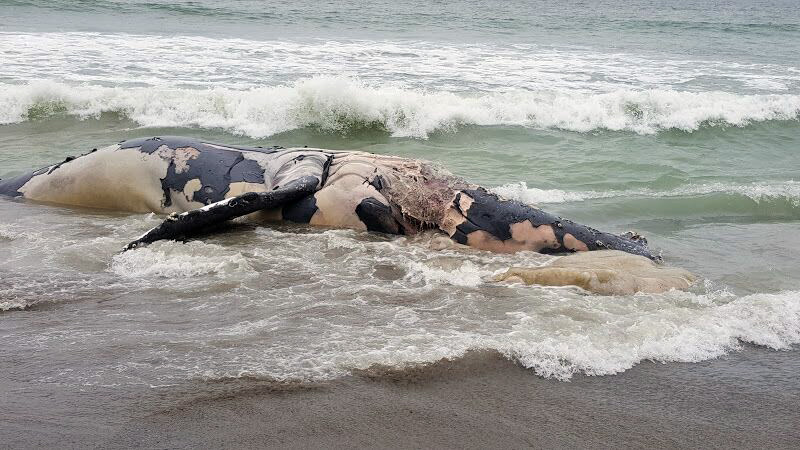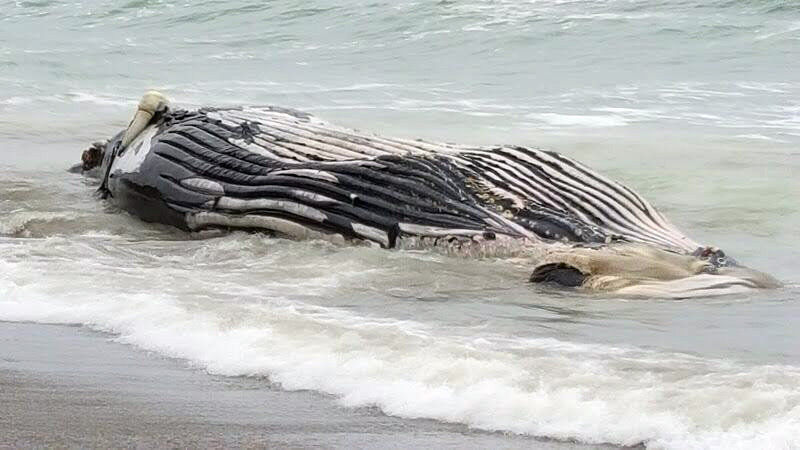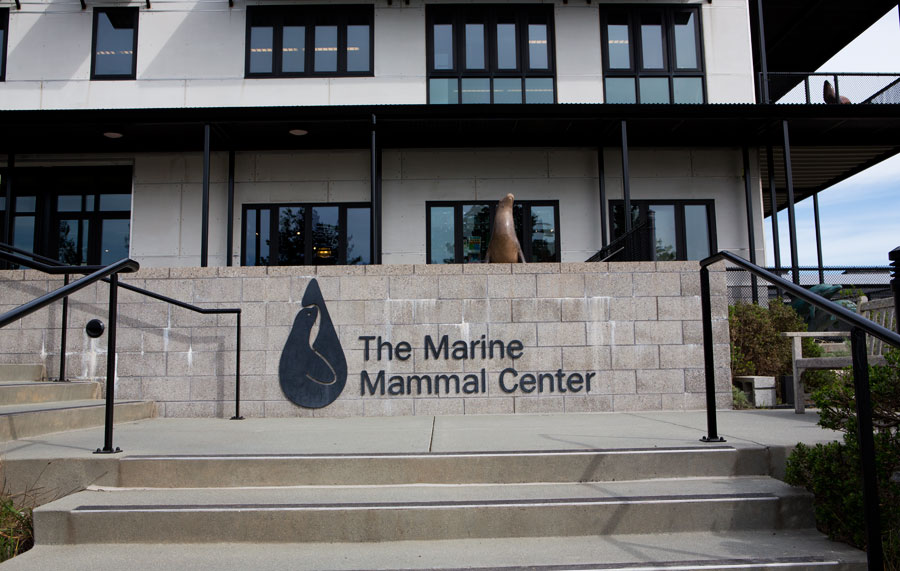The Marine Mammal Center in Sausalito confirms that a 38-foot humpback whale carcass has washed ashore at Esplanade Beach in Pacifica. It’s the third whale to wash ashore in the Pacifica area this summer.
The Center received initial reports from a member of the public early in the morning on Sunday, August 2, 2015. Around 4pm the same day, scientists from The Marine Mammal Center and The California Academy of Sciences arrived on the scene to perform a partial necropsy to try to determine cause of death and collect samples.
Scientists discovered damage and internal hemorrhaging on the left side of the whale below the pectoral flipper. This type of trauma is consistent with blunt force trauma and may be associated with a vessel collision but scientists are not making a final determination until more experts can look at the information obtained by the necropsy team.
“By examining marine mammals that wash up on our shores, we are able to learn more about how we can prevent future deaths,” says Dr. Shawn Johnson, Director of Veterinary Science at The Marine Mammal Center. “Even in the case of an animal that is starting to decompose, we may be able to document human impacts such as ship strikes that could help influence changes in shipping lanes.”
On June 24, 2015, NOAA’s Greater Farallones and Cordell Bank national marine sanctuaries requested large ships slow down inside the shipping lanes beyond San Francisco’s Golden Gate to reduce the threat of ship strikes on endangered blue, humpback and fin whales. Throughout the month of July, Bay area biologists and researchers reported seeing large groups (75-150) of foraging whales in the Greater Farallones and Cordell Bank national marine sanctuaries.
NOAA recommends that all vessels of 300 gross registered tons or larger reduce speeds to a maximum of 10 knots per hour (approximately 11.5 mph) from May through November 15 when whales gather to feed. The whales are protected under the federal Endangered Species Act, the Marine Mammal Protection Act, and the National Marine Sanctuaries Act. The U.S. Coast Guard is currently broadcasting this speed reduction request in its Notice to All Mariners.
“By working with the maritime shipping industry, conservation groups, and others, we hope to minimize the outcomes of impacts from vessel-whale interactions,” said Maria Brown, superintendent of Greater Farallones National Marine Sanctuary. “At lower ship speeds whales are more likely to survive collisions.”
The Marine Mammal Center has responded to 17 stranded cetaceans – whales, dolphins and porpoises – so far in 2015, including two other whales that stranded in Pacifica, and a bottlenose dolphin that stranded in San Francisco in July. Since 2005, the Center has responded to anywhere from two to ten stranded whales each year, as well as stranded dolphins and porpoises.
In 2015 The Marine Mammal Center has responded to the following animals:
– January, Point Reyes National Seashore – pygmy sperm whale, currently awaiting histology reports
– April, Pacifica – sperm whale, cause of death: unknown
– April, Fort Bragg – orca, cause of death: entanglement
– May, Pacifica – humpback whale, cause of death: trauma consistent with ship strike injuries
– May, Sonoma – gray whale, cause of death: unknown
– July, San Francisco – bottlenose dolphin, currently awaiting histology reports
– July, San Francisco – harbor porpoise, trauma
The whale is a 38-foot male sub-adult humpback whale. Due to the decomposed state of the animal, scientists were only able to perform a partial necropsy. The Center has responded to 22 humpback whales in its 40-year history, including a response to Humphrey in 1985 and 1990, and Delta and Dawn in 2007 – all three in the San Francisco Bay.
The Marine Mammal Center collected additional samples to contribute to various research studies. The California Academy of Sciences archived several bones into the scientific collection. The bones will be available to researchers from around the world.
BACKGROUND:
Humpback whales are one of the most frequently seen whales in California. They regularly migrate through California waters and are visible by boat offshore. Humpback whales are listed as endangered under the Endangered Species Act.
“Every stranding represents an opportunity for us to learn more about this species and our ocean environment,” says Lauren Rust, Research Biologist at The Marine Mammal Center. “There tend to be peaks in whale strandings in the spring and fall, aligned with the migration and calving season.”
Among the many threats faced by whales today are ship strikes, which occur more and more in busy shipping lanes. A collaboration of government agencies, academic institutions, nonprofit conservation groups and private-sector companies have developed Whale Alert, an app that helps reduce the chance of fatal ship strikes by large vessels. The app can be used by anyone out on the water to report concentrations of cetaceans. It displays active whale management areas, required reporting areas, recommended routes, areas to be avoided and near real-time warnings in shipping lanes along the east and west coasts of the United States and Canada. This information allows vessel operators to avoid collision with whales by slowing down and heightening their visual awareness. For more information visit: Whalealert.org
How the public can help:
– Report sick and injured marine mammals to The Marine Mammal Center by calling 415-289-SEAL (7325).
– Maintain a safe distance of at least 50 feet from marine mammals and keep dogs away.
– The Marine Mammal Center is a nonprofit facility and depends on donations from members of the public to respond to and care for animals such as this stranded whale.
Visit https://www.MarineMammalCenter.org/donate to help the Center perform its life-saving work.
About The Marine Mammal Center:
Founded in 1975 out of compassion for stranded seals and sea lions, The Marine Mammal Center has evolved into the world’s largest marine mammal rehabilitation hospital. In addition to the rescue of marine mammals, this nonprofit organization is internationally acclaimed for its scientific research and educational programs. As a true teaching hospital, the Center hosts veterinarians from around the world who come to train and gives schoolchildren the opportunity to slip into the mindset of marine biologists, developing a passion for the ocean environment and its protection.



